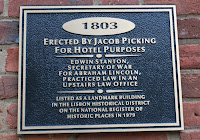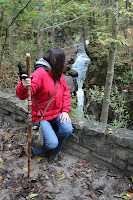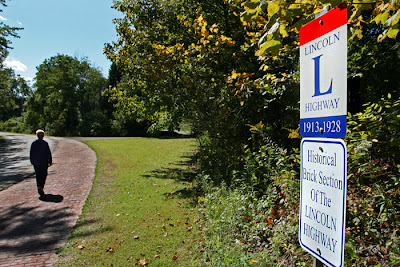TRAVELING ACROSS OHIO--
On the Lincoln Highway
My sense of history tingled as Sue and I pondered the above stretch of the Lincoln Highway (LH) about mid-way between East Canton and Minerva. Notice both the original brick pavers and the width of the "highway" compared to the modern automobiles.
The current highway seems to exist in three phases. the earliest being the brick pavers, the second being the old routing which has turned into secondary back roads and the third being modern, four lane highway which often has been built on top of the original alignment.
There are only short and fragmented sections of the original brick surface remaining. Some of the old alignment even has reverted to private ownership.
Imagine! About 100 years ago there was no paved road across the United States.
A vehicle trip across the country then would take about 60 days; 90 days if difficulties were encountered.
The first cross country drive was done in 1903. In 1911 the president of the Packard Motor Car Company, Henry Joy, and his chief engineer decided to drive west from Detroit to test his new automobile. At Omaha they asked a Packard dealer for directions west.
The dealer got in a car and led them a bit west where they encountered a wire, ranch fence. "Just take the fence down and drive on," he said. "When you get to the next fence take that down and go on again."
"A little further," Joy said, "...there were no fences...nothing but two ruts across the prairie."
The proclamation honoring Lincoln and launching the new route was released in September 1913.
One history describes the Pennsylvania Turnpike in 1940 becoming the ultimate by-pass of the original LH; "...the original roads becoming faint traces in the woods, their secrets fading into the bramble."
Following the original highway alignment today is a challenge. The nifty red, white and blue markers with the big "L" in the middle are only as prominent and numerous as local volunteers have the capacity to maintain them.
In our area they are abundant. Over near East Liverpool they are virtually non existent.
We drove the oldest alignment we could find; route 430 and County Road 30 to Wooster, for example. From there to east of Canton it was a combination of four lane highway and old segments like Lincoln Way East from Wooster for awhile.
There is an original segment through Dalton but even part of it was under construction when we passed by. A little east of there you can take route 172 through Massillon, Canton and East Canton where you will rejoin the old, 2 lane US 30.
That alternates with old segments and modern 4 lanes on to East Liverpool. We managed to cross the

Newell Bridge over the Ohio River in E. Liverpool (toll 75 cents) which was one of two ways the highway arrived in Ohio from the east.
The other headed north in West Virginia crossing into Pennsylvania where it joined State Route 39 back into Ohio. We tried that but were baffled by the absence of adequate signs and wound up recrossing the Ohio River via US 30.
We bounced through East Liverpool's version of streets and headed back on Ohio 267, the old alignment toward Lisbon where we unloaded at our motel, had dinner at a marvelous local restaurant, Pondi's, then waited for darkness so we could do the photos of the diner in the original story of this series.
Pondi's, by the way, was established in 1916 at this very same location with Aunt Anne Pondi selling burgers on the front porch of her home. Today's restaurant is an addition to that very house and still is going strong. Stop there for a bite and you will know why.
We returned to Mansfield the following day mostly via the modern US 30 with a stop at Smucker's retail shop south of Orville, lunch in Wooster, then the Pine Tree Barn, not on the LH but certainly worth a peek.
The bronze casting in the small photo above right is on a building being refurbished in downtown Lisbon. Note it tells of Lincoln's secretary of war having a law practice in this very building. (Remember to click on that image for a larger view). The LH route through downtown Canton is shown above.
While preparing to launch our exploration of the highway in western Ohio we poked around the Mansfield area a bit more and made the delightful discovery of this segment of original brick pavement on Windsor Rd. Windsor Rd., wyes off US 42 near Laver Rd., northeast of Mansfield and rejoins US 42 about one mile northeast of the Richland/Ashland county line. This small section of brick surface is in Ashland County.
Note the sign shows the dates of 1913-1928. The original alignment of the LH left Wooster and went to Ashland via what is now US 250 then rejoined route 30 via US 42 in Mansfield. Windsor Rd., was route 42 in those days, likely bypassing the swampy area near the county line.
Today's LH alignment between Mansfield and Wooster began after 1928 and followed what we now know as route 430 and County Rd., 30 A through Mifflin, Hayesville, Jeromesville, etc. until it was replaced by the modern US 30; now a four-lane highway.




































